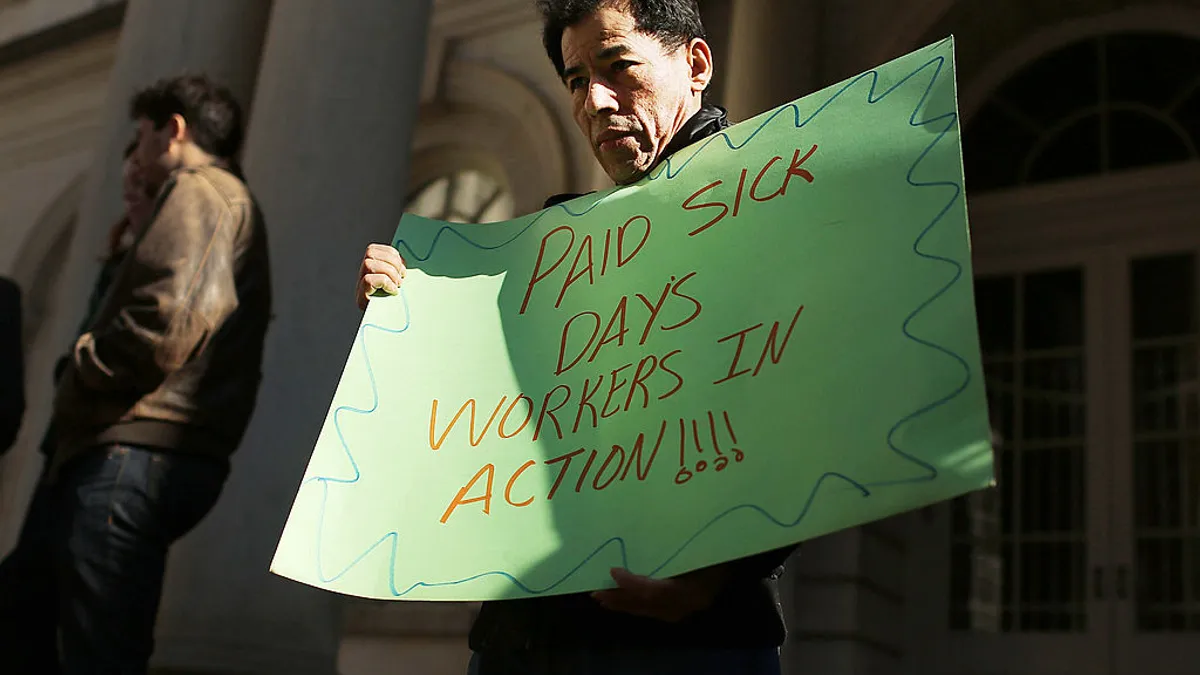"Mo' money, mo' problems," goes the famous hip-hop aphorism. But in the retail workplace, does more money mean fewer problems?
With retailers from Ikea to Wal-Mart turning to higher wages to curb the trendof high employee turnover, it's easy to think of raising wages as a blanket solution to solving workforce engagement and retention. But money is not all that matters, according to Christa Foley, head of corporate culture consultancy Zappos Insights.
Employers should look to pay a fair market value for any employee, Foley told Retail Dive in an exclusive interview, but money isn’t the number one thing that makes workers productive and happy.
Instead, employee engagement may be the best strategy to foster productive and happy workforces.
“While I applaud those employers for bumping people above minimum wage, because I think it’s tough to live on the minimum wage, I don’t think that should be the focal point," said Foley. "It shouldn’t be about the dollar.”
Are higher wages really a quick fix?
Though higher wages isn’t a cure-all to employee discontent, it does help retailers compete in the “highly competitive talent market,” according to Harvard Business Review's report, “The Impact of Employee Engagement on Performance.” This may be a new normal for retailers, especially as the economy picks up and employee retention becomes a mounting problem for retailers of all sizes.
The cost of losing employees is a primary reason why retailers are narrowing in on this issue. A 2012 study produced by the Center for American Progressfound that employers spend about one-fifth of an employee’s salary to replace that worker. For positions earning $30,000 or less (the median annual pay for a retail worker in 2012 was $21,410, according to the Bureau of Labor Statistics), the cost of replacing an employee is about 16% of the employee’s annual salary.
But wages might not be the quick and comprehensive fix that retailers think they are in terms of increasing employee engagement and retention, especially with younger workers.
At Zappos, an e-commerce shoe retailer and independent subsidiary owned by Amazon, known for its zany culture and fanatical obsession with the customer, a fixation with money and raises may even be a negative for potential employees as it means they might not be a good fit with the culture, according to Foley.
Foley has been with Zappos for 10 years. Notably, she was the head of human resources at the retailer for seven and a half years, helping the company grow from less than 100 employees to 1,500. She now oversees Zappos Insights, a B2B unit that helps other companies create the same level of culture and employee engagement found in Zappos today – literally monetizing the company’s culture. Foley was a key player in helping Zappos transition to its famed holacracy management model, which prioritizes teams over hierarchies for every meeting and project.
While Foley says that Zappos compensates their employees for a job well done, "if your priority and focus is money, that's probably not going to fall in line with our core culture."
That may work well for younger workers at Zappos. While the paycheck might have been the primary driver of employment in the past, more millennials aremotivated by their work’s purpose than their salary. A 2012 report from Bentley University, "Millennials in the Workplace" states that "success isn't about fame or who has the biggest paycheck." Instead, millenials are happy with work that "makes a difference in the world" and a job where they are "part of the solution."
The cost of unhappy employees
If retailers can't keep workers happy and productive through moderate wage increases alone, how can they solve the problem? For Zappos, it comes down to employee engagement.
"What we do at Zappos is encourage employees to bring their full self to the job," said Foley.
Zappos has a team of employees dedicated to employee engagement. Its mission is to “provide fun and engaging opportunities for employees that speak to their individual passions.” The team helps deliver programs that foster recognition and mentorship in the company, as well as team-building activities.
Defined by Gallup, employee engagement is an employee being “emotionally invested in and focused on creating value for their organizations every day,” and is an oft-cited measurement and method to help retailers and other businesses increase labor productivity and compete for top talent.
But increasing employee engagement is not only good for employee performance, retention, and public perception: It’s also good for business.
Actively disengaged employees in the U.S. make up around 18% of the workforce, according to Gallup’s “State of the Global Workplace Report 2013.” The top 25% of work places in Gallup’s client database have “significantly higher productivity, profitability, and customers ratings, less turnover and absenteeism, and fewer safety incidents than those in the bottom 25%.” Organizations in Gallup’s client database with only one actively disengaged employee for every 9.3 engaged employees in 2010-2011 experienced 147% higher earnings per share compared with their competition in 2011-2012.
In the Harvard Business Review report, senior executives acknowledged that a highly engaged workforce can “increase innovation, productivity, and bottom-line performance while reducing costs related to retention in highly competitive talent markets.”
"If you [encourage employees to bring their full selves to work], you don't have work-life balance — you just have life," Foley said. "People don't feel like they're cutting off a piece of themselves at the workforce. They'll feel happier and engaged, they'll feel appreciated because they won't feel siloed into a certain box that they have to be in at work."
What retailers can do — without cloning Zappos' culture
While Foley doesn’t see Zappos’ culture as a one-size-fits-all solution for retailers, the company’s take on employee engagement has clearly worked for them.
“[Zappos Insights’] goal is to not make clones of Zappos. What works for us works for us because of our culture,” Foley said. "What we want to impress upon these companies is that you can be a successful business and pay attention to your people, and pay attention to culture."
Foley lists some ways that businesses can create a successful and happy company culture, including a robust hiring and on-boarding process, making employees feel valued, and impressing on the employee the company’s core values and what those look like in practice.
Gallup's report also recommends actions companies can take to improve engagement, including selecting the right managers, making managers responsible for their employees’ engagement, and making employee engagement part of the company’s culture and a top priority for executives.
Engaging the employee from the first day on the job is key, according to Foley. All new full-time employees at Zappos, no matter the position, go through four weeks of onboarding. Half of the time is devoted to learning the company’s core values and what they look like while on the job. The other 50% is spent in the department that put Zappos on the map – its call center, where over 500 employees work to answer 80% of customer inquiries within 20 seconds.
Once on-boarded, Foley says that businesses should be confident in their employees’ abilities, giving them the freedom to utilize their talents to get the job done.
“Don’t just throw people out on the floor and hope they get it right. Make sure you give some thought on how they are trained, then treat them like adults," said Foley. "You’ve hired the right people, you’ve given them the tools to get it right — you shouldn’t have to worry about the things that HR normally worries about if you’ve done those front things.”
Learning to love 'the red-headed stepchild’
Good intentions are one thing, but retailers may find it difficult to maintain a “robust hiring and on-boarding process’’ during peak holiday times, when thousands of employees need to be on-boarded at once.
Foley lists two alternatives to the traditional holiday training process. For small to medium sized retailers, everyone — even top C-suite executives — can work the shipping floor or call center, helping employees on the ground and minimizing the need for temporary help. Zappos maintained this policy until three years ago, with every Zappos employee, including CEO Tony Hsieh, taking 10 hours of calls during the holiday periods.
Foley admits this policy might not work for bigger retailers, who may be forced to hire thousands of temporary staff during their busiest times.
In the last three years, when Zappos has been working with temp agencies to hire temporary staff, Foley makes sure that the agency has a clear sense of the Zappos culture and screens applicants accordingly before they are selected. These temporary workers receive a short, abridged version of Zappos’ four week training and once they are put out on the floor, they are recognized for their help.
“I’ve worked in the temp staff world, and I know what its like,” Foley said. “I know at some companies the supplemental staff is treated as the red-headed stepchild.”
Zappos includes these staff in all the same activities as full-time employees. Foley believes this, and the appreciation exuded from the full-time staff, makes them a little more invested in the Zappos’ culture and bottom line.
“Everyone goes out of the way to show them how much they value them," she said. "We do our best, as with any customer, to make them feel the wow of Zappos.”
By valuing an employee — even a temporary worker — on the same level as the customer, retailers may be able to foster the same holy grail of emotions in their workforce that they strive to nuture with customers everyday: engagement, retention, and loyalty.






















